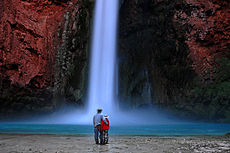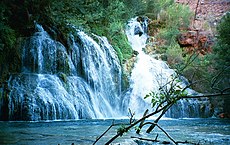Havasu Creek
Havasu Creek is a stream in the U.S. state of Arizona associated with the Havasupai people. It is a tributary to the Colorado River, which it enters in the Grand Canyon.
About
Havasu Creek starts out above the canyon wall as a small trickle of snow run-off and rain water. This water meanders on the plains above the canyon for about 50 miles (80 km) until it enters Cataract (Havasu) Canyon. It then reaches Havasu Springs, where an underground river feeds the creek. This spring can be accessed by heading upstream when the creek is first encountered. The water stays at about 70 °F (21 °C) all year around. The creek is well known for its blue-green color and distinctive travertine formations. This is due to large amounts of calcium carbonate in the water that formed the limestone that lines the creek and reflects its color so strongly. This also gives the creek an interesting feature as it is ever changing. This occurs because any items that fall into the stream mineralize very quickly, causing new formations and changing the flow of the water. This causes the creek to never look the same from one year to another. The creek runs through the village of Supai, and it ultimately flows into the Colorado River.
Navajo Falls


Until the August 2008 flooding, Navajo Falls was the first prominent waterfall in the canyon. They were named after an old Supai chief. It was located 1.25 miles (2 km) from Supai and is accessed from a trail located on the left side (right side when heading upstream) of the main trail. This side trail leads down to the creek, where there is a crude bridge that crosses over the creek. The trail then leads back into the trees, where the main pool and falls were located. The pool was popular for its seclusion and its ease to swimmers. The falls were approximately 70 feet (21 m) tall and consisted of separate sets of water chutes, the main one located on the right side where the water cascaded down the canyon hill. To the left of the main chute there were other smaller ones that were steeper and more vertical. There were a few places that are viable for cliff jumping, although caution was necessary.
In August 2008, Navajo Falls was completely bypassed by a flood. According to The New York Times:
Within 12 hours, several surges of high water roared down the creek, destroying the campground, stranding a Boy Scout troop from New Jersey and setting off a massive mudslide that obliterated Navajo Falls, one of four spectacular canyon waterfalls that attract tourists from around the world.[1]
Despite this early report, the site of the falls still exists; the mudslide simply rerouted Havasu Creek, creating two new falls.[2]
Upper Navajo Falls

This waterfall, also called New Navajo Falls, came into being in the 2008 flood that bypassed Navajo Falls and is now the first waterfall in the canyon. The falls are about 50 feet (15 m) tall and fall into a rocky pool.[3]
Lower Navajo Falls

This waterfall, also called Rock Falls, is the second one created by the 2008 flood, about .15 miles (0.24 km) below Upper Navajo Falls. The creek falls about 30 feet (9.1 m) into a swimming hole.[4]
Havasu Falls

Havasu Falls (Havasupai: Havasuw Hagjahgeevma[5]) is the third waterfall in the canyon. It is located at 36°15′18″N 112°41′52″W / 36.25500°N 112.69778°W (1 ½ miles from Supai) and is accessed from a trail on the right side (left side when heading upstream) of the main trail. The side trail leads across a small plateau and drops into the main pool. Havasu is arguably the most famous and most visited of all the falls. The falls consist of one main chute that drops over a 100-foot (30 m) vertical cliff[6] (due to the high mineral content of the water, the falls are ever-changing and sometimes break into two separate chutes of water) into a large pool.
The falls are known for their natural pools, created by mineralization, although most of these pools were damaged and/or destroyed in the early 1990s by large floods that washed through the area. A small man-made dam was constructed to help restore the pools and to preserve what is left. There are many picnic tables on the opposite side of the creek and it is very easy to cross over by following the edges of the pools. It is possible to swim behind the falls and enter a small rock shelter behind it.
It is interesting to note that the falls were called "Bridal Veil Falls" before the flood of 1910 because they fell from the entire width of the now dry travertine cliffs north and south of the present falls.
Mooney Falls

Mooney Falls is the fourth main waterfall in the canyon. It is named after D. W. "James" Mooney, a miner, who in 1882 (according to his companions) decided to mine the area near Havasu Falls for minerals. The group then decided to try Mooney Falls. One of his companions was injured, so James Mooney decided to try to climb up the falls with his companion tied to his back, and subsequently fell to his death. The Falls are located 2.25 miles (3.6 km) from Supai, just past the campgrounds. The trail leads to the top of the falls, where there is a lookout/photograph area that overlooks the 210-foot (64 m) canyon wall that the waterfall cascades over. In order to gain access to the bottom of the falls and its pool, a very rugged and dangerous descent is required. Extreme care and discretion for the following portion is required; it is highly exposed and should not be attempted when the weather and/or conditions are not suitable.
The trail down is located on the left side (looking downstream), up against the canyon wall. The first half of the trail is only moderately difficult until the entrance of a small passageway/cave is reached. At this point the trail becomes very difficult and very precarious. The small passageway is large enough for the average human, and leads to a small opening in which another passageway is entered. At the end of the second passageway the trail becomes a semi-vertical rock climb that is similar to descending a ladder. Strategically placed chains, handholds, and ladders aid in the climb.
Mist from the falls often makes the rock slippery, and the climb is also difficult because of having to pass people going in the opposite direction. The pool is the largest of the three, and some people jump from low cliff ledges into the pool. It is possible for strong swimmers to swim to the left of the falls to the rock wall and then to a small cave that is located just above the water line, approximately 15–20 feet (5 to 6 meters) away from the falls. An island breaks the pool into two streams.
Beaver Falls

Beaver Falls is arguably the fifth set of falls, although many claim that it is not a waterfall, but merely a set of small falls that are located close to each other. The falls are located approximately 6 miles (9.7 km) downstream of Supai, and are the most difficult to access. After the descent to Mooney Falls, a visible trail leads downstream.
About .25 miles (0.40 km) down, a small stream feeds into the creek, over the side of the cliff, effectively creating a place to shower. The trail leads to the right towards the creek, then back towards Mooney Falls to get to this mini-waterfall.
The next 3–4 miles are remote and rugged. The trail is not always easy to follow and requires multiple crossings of the creek. At one point, on a rock ledge, a rope has been placed for climbing. It is a difficult climb of around 8 feet (2.4 m), but the rope is located above the water, so any fall is lessened.
Farther downstream, a rock chute/slide provides one access to Beaver Falls. Easier access is further along, just before the trail turns north to continue down the canyon. River rafters have beaten a path to the ledges where they jump. Turning upstream from here, it is possible to gradually get to the creek bed and follow it further upstream to the falls. The pools here are small, but still offer good swimming.
Beaver Falls was once much more impressive. It had a height of about fifty feet in one fall, at the junction of Beaver Canyon and Havasu Canyon. The great flood of January 1910 destroyed it, leaving the falls over the limestone ledges as they are today. Rotted cottonwood logs near the aforementioned junction show how high the water rose during that flood.
Confluence
From Beaver Falls, the creek heads down to the Colorado River. There are multiple ways to reach the river, including going back up the chute to the trail and continuing downstream. The 3 miles (4.8 km) hike is long, difficult, and rugged, and it is advisable only for experienced hikers. The creek ends at the confluence, where there are some camping areas. This spot is also popular for river rafters to stop and to head up the canyon.
Flooding
On August 17, 2008, the Redlands Dam on Havasu Creek burst after days of heavy rain. The potential threat to human life by the floodwaters caused the local authorities to evacuate the village, and rescue crews airlifted about 400 people to safety.[7] In addition, Navajo Falls was bypassed in the flooding and new falls—Upper Navajo Falls and Lower Navajo Falls—were formed. [8][9]
Gallery
-
Mooney Falls in the morning
-
Navajo Falls before the flood
-
Havasu Falls at night
-
Mooney Falls
-
Beaver Falls
-
Havasu Falls in December
References
- ^ http://www.havasupaifalls.net/navajo.html
- ^ http://www.havasupaifalls.net/newnavajo.html
- ^ http://www.havasupaifalls.net/rock.html
- ^ Hinton, Leanne (1984). A dictionary of the Havasupai language.
- ^ "Waterfalls of Havasu Canyon". Retrieved 2013-06-12.
- ^ Reid, Betty (August 17, 2008). "Hundreds Evacuated Near Grand Canyon After Flooding". The Arizona Republic. Retrieved November 29,2012.
{{cite news}}: Check date values in:|accessdate=(help); Unknown parameter|coauthors=ignored (|author=suggested) (help) - ^ Fonseca, Felicia (June 2009). "Havasupai Reopen Flooded Site to Visitors". News from Indian Country. Retrieved January 26, 2012.
{{cite news}}: Unknown parameter|coauthor=ignored (|author=suggested) (help) - ^ http://www.havasupaifalls.net/navajo.html






